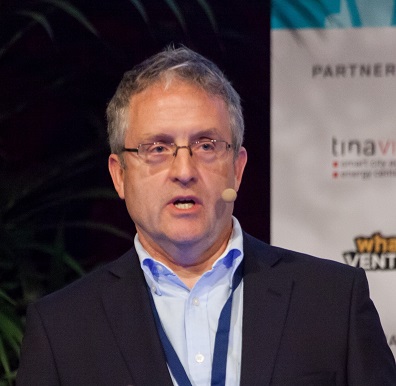Demand growing fast for digital twins and AI in automotive, power generation and aviation, says GE’s CDO

EXCLUSIVE INTERVIEW: Autonomous systems, supported by artificial intelligence (AI) and digital twins, are a game-changer for industrial organisations. Today we are moving away from people telling machines what to do to a world where machines tell people what to do.
In this exclusive interview, Bill Ruh, CEO of GE Digital tells editorial director, Jeremy Cowan that his company saved US$1 billion (€0.85 billion) in 2017 through productivity gains from using its Predix platform and AI-based applications for factories, power plants, aircraft and energy turbines.
IoT Now: In what industries and geographies are autonomous systems, supported by AI and digital twins, in use today?
Bill Ruh: Digital twins are becoming increasingly common in all industries and are used all over the world. From oil & gas (O&G) pipelines in the middle east to wind turbines in the North Sea, they are being implemented across multiple sectors. GE Digital has 1.2 million digital twins in operation today. Initially, GE Digital saw strongest traction in the energy and aviation sectors, but we are today seeing rising interest in manufacturing industries as well as FMCG (fast moving consumer goods) and automotive.
Digital twins today are predominantly used for industrial assets that generate a lot of data and are connected to the Industrial Internet or Industrial Internet of Things (IIoT). This is especially true for assets that are on the critical path of the company. Any downtime of the equipment would generate huge profit loss so it’s relevant to leverage the value from data, to predict asset behaviour.
For instance, this technology has increasingly been adopted in engineering and manufacturing to create virtual replicas of complex and data-intensive physical assets such as an airplane engine or IoT-enabled industrial robots. Such intelligent systems are especially prevalent in automotive, the heavy industries, energy and power generation, aviation and many more.
However, while digital twins are intelligent systems, it’s important to understand that they are not always fully autonomous. AI-based applications and digital twins still require a lot of human intervention, particularly in scenarios where virtual replicas of machines are being used to test new features and modifications of physical assets. In industry, AI instead of human (intelligence) is not necessarily more efficient. But human skills boosted by AI analyses and recommendations is more productive.
IoT Now: Which industry sectors do you expect will grow AI the most in the next five years?
BR: Industrial internet will fuel unprecedented gains in productivity and innovation for industrial companies by enabling the wider adoption of AI and digital technology. Our own estimates suggest the Industrial Internet could be a $225 billion (€192.05 billion) market by 2020. Moreover, our data indicates that the adoption of Industrial Internet technologies could add between £200 Billion (€226.04 billion) and £320 Billion (€361.67 billion) to the UK’s GDP by 2030.

Bill Ruh
This is a huge opportunity for organisations, for society and for the economy. In terms of sector-specific growth, our experience shows that the Industrial Internet is having a profound impact on the manufacturing sector as well as the aviation and transportation industries.
Automotive and FMCG are the next big industries to adopt IIoT technologies. Leading energy companies have already started to adopt – which is creating pull-through for other companies in that sector. The same is true in aviation, O&G and healthcare.
IoT Now: What is the USP for GE’s Predix platform? Why would users choose it?
BR: A platform is only as good as its apps. Our Predix-Powered “killer apps” for industry are APM (Asset Performance Management) and FSM (Field Service Management). These are helping customers – almost out of the box – to dramatically increase productivity with quick time to value. This is essential when making purchasing decisions.
Longer term, customers are drawn to Predix’s open architecture, which allows them to integrate our solutions into their existing software infrastructure – and enables them to scale the technology relatively easily, to assets and factories around the globe.
Predix is the world’s first and only platform built exclusively for the Industrial Internet – connecting machines, data and people to power the digital industrial companies of the future. It is the only software platform that offers complete connectivity from the edge to the cloud and computing capabilities at every level of the industrial software stack.
As such, one of the key differentiators of this technology is its data computational power. Predix helps manage and implement the most meaningful statistical analysis, data mining, and retrieval processes for Big Data to help organisations identify key insights and trends. What that means is that organisations can tap into the massive computing power in the cloud – to run huge numbers of algorithms simultaneously and perform superfast real-time analytics directly ‘at the Edge’ – i.e. on the ground where the asset is. This combination is really powerful, especially in industrial settings.
What’s more, Predix enables organisations to tap into our large ecosystem of partners and developers, which allows them to innovate faster and at scale. Currently, our Predix platform comprises more than 100 industrial applications and we have more than 1,100 partners and 38,000 developers using the technology. Overall, there are 1.2 million digital twins and 310,000 assets under management connected to Predix.
IoT Now: Can you describe your range of AI-based applications for factories, power plants, and aircraft?
BR: Machine learning algorithms are baked through our Predix-Powered offering. Our first ‘killer app’ for industry is Predix Asset Performance Management (APM). APM solutions help monitor hundreds of thousands of industrial assets around the globe. This technology allows our customers to predict when their machines are going to fail and to improve asset maintenance.
The second area we are focusing on is Field Service Management. Our Field Service Management solution (Predix ServiceMax) helps organisations assign, dispatch and outfit field service technicians in the most efficient way to improve work efficiency and optimise operational outcomes.
We also have GE Brilliant Manufacturing, which offers a suite of AI-powered software solutions that help improve efficiency, quality and operations management across factories and plants

Jeremy Cowan
And finally, we have a specialist service offering designed to help our customers make the most out of their assets through AI. For instance, we have the European Foundry team in Paris which includes dedicated teams of engineers and data scientists who monitor industrial assets remotely.
They use AI-based data insights from digital twins and other digital apps to help our customers identify potential issues and resolve key business challenges. Our digital Foundry also helps industrial companies in their digitisation journey, wherever they are in this process, with support from our experts in design thinking, data science, developers…
IoT Now: Who are your new strategic partners in the UK and Europe and what do they add to the ecosystem?
BR: We have plenty of strategic partners in the UK and Europe and we are continuing to expand our ecosystem of partnerships to drive further innovation and growth in the region.
Our main partners include Cap Gemini, Novotek, who are our main UK and North Europe Channel Partner, as well as Vodafone who are using Predix for a Healthcare project. We also work with Irlynx – one of the alumni start-ups from our Foundry acceleration programme, who are working with Vodafone on an intelligent lighting project.
We are also partnering with the Manufacturing Technology Centre (MTC) by supporting the MTC with active Predix accounts and technical support. MTC developers will travel to the GE Digital Foundry in San Ramon to participate in a collaborative programme where they will work with our engineers to fast track their Predix App and enhance their own developers’ proficiency in working with Predix. Our platform will also be used as a User Interface and Platform for the Data Service for the Demonstrator, Virtual Factory and Digital Twin within their Factory in a Box offering.
Bill Ruh was talking exclusively to Jeremy Cowan, editorial director of IoT Now, IoT Global Network and IoT Now Transport.
Comment on this article below or via Twitter @IoTGN
